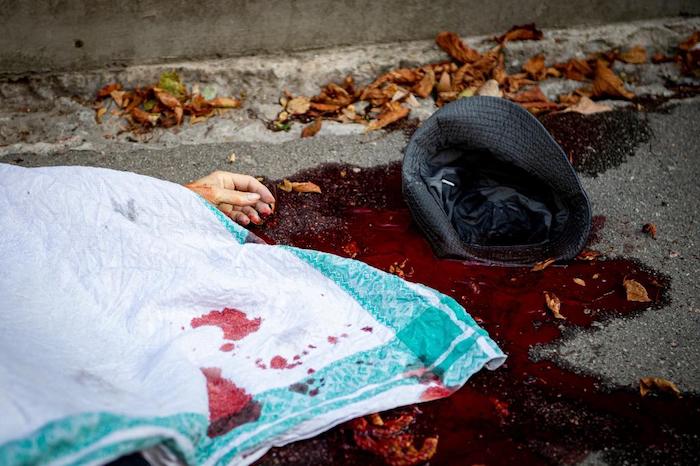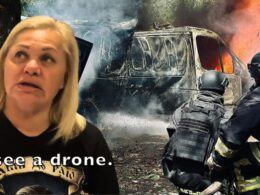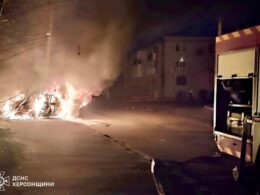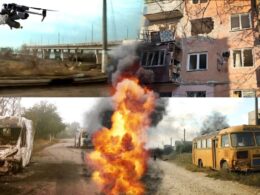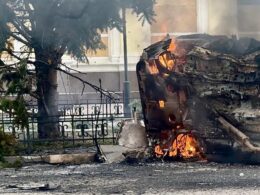Destruction of Kherson
Inna, a young film director, and an expectant mother, came to a Kherson humanitarian aid hub looking for help. With no makeup, and wearing a T-shirt with a cartoon scaly dragon, she looked like a student heading for a bookstore. Instead, Inna found piles of rubble all around the street. A Soviet-made 1962 GRAD rocket stuck from the hole in the asphalt, next to a lost toy dinosaur. The hub got hit by a Russian MLRS rocket the previous night. Another rocket destroyed the building next to Inna’s home. Inna had previously left Kherson but came back after several weeks. The family could not afford to rent an apartment in Odesa.
“Living in a refugee communal living space in Mykolaiv isn’t good for a newborn,” said Inna. “Yet, living here, at home, is scary. We don’t know what to do. My husband’s home in Oleksandrivka, a village near Kherson, was destroyed by Russians. We lost our homes and jobs.”
Inna’s family story is typical for Kherson. Serhiy and Yana, volunteers at the recently destroyed humanitarian hub, spent most of their time volunteering and intended to continue. Warm clothes and blankets got damaged during the night attack but, luckily, the fund’s food warehouse, located blocks away, survived the night’s attack.
“I come here and I feel better. My workplace burned,” said Yana. “I used to work at a café downtown. Now I live in a basement.”
“My workplace of work drowned,” added Serhiy, a former seaport technician.
Like Inna’s family, the majority of the remaining residents of Kherson rely on volunteers and charities for food deliveries. Humanitarian aid hubs are at risk: as a part of their war on civilians, Russians deliberately target places for aid distribution and attack the adjacent areas with parked transportation.
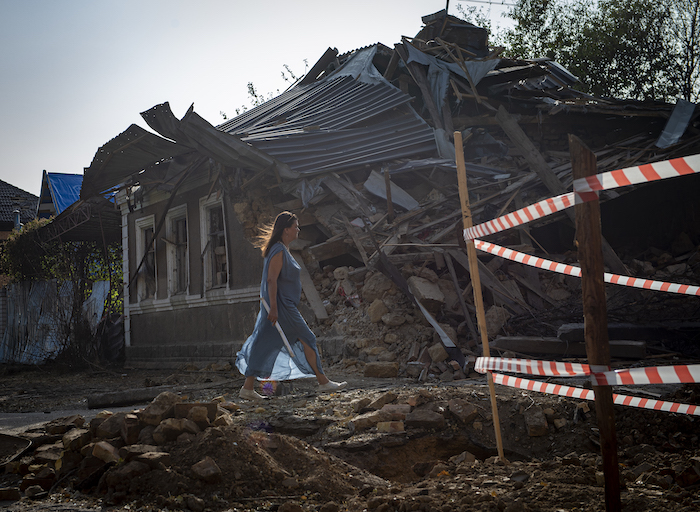
At another humanitarian aid hub also located at a regular residential building, a group of twenty citizens, mostly in their 50s and 60s, form a human chain to unload diapers, blankets, and canned food as fast as possible. Speed is critical for staying alive: Russian intelligence drones circle in the sky, searching for gatherings of people.
Scorched-earth policy
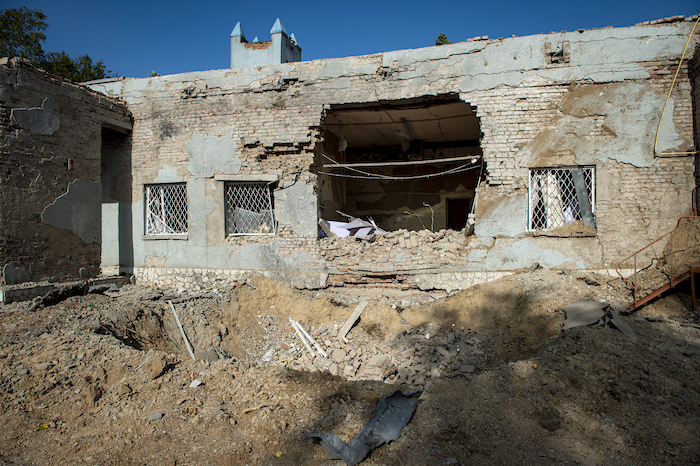
“The Russians continue to inflict damage specifically on civilian infrastructure,” said Dmytro Pletenchuk, the speaker of the Naval Forces of the Armed Forces of Ukraine. “Whenever they hit civilians in Aleppo, they always said that this was the headquarters of ISIS. And they do the same in Ukraine. Wherever the rocket falls, they call it ‘the location of the headquarters.’ This is their information policy.”
Russia's “scorched-earth tactics” have been a hallmark of its military strategy, from historical conflicts to the current war in Ukraine. This policy aims to destroy virtually all valuable resources to an enemy, including vital resources like water, food, human lives, animals, vegetation, tools, and infrastructure.
Volodymyr, another volunteer, lost several minivans to the fire after such an attack. Yet, Volodymyr continues to deliver food and hygiene goods in his old Volvo, also damaged after a missile hit his house, to the districts located close to the Dnipro River. These areas are under constant fire and are monitored by the Russian military drones from the other bank. Most volunteers do not risk driving to the river as Russians aim at civilian cars.
Residents of the houses on the river are not just under round-the-clock fire: vulnerable population groups are stranded without food and first necessities, often without power after attacks.
As Volodymyr delivers canned food and diapers to a family of four, with one child bed-ridden, he finds them hiding in a storage room for hours as the air raid continues. Moving is out of the question: the family has no means to move.
Volodymyr visits another family with a young child with special needs. The mother spent nine months of the occupation without ever leaving the house and stepping outside for fear of her son being kidnapped by the Russians. Russians practiced taking children to the Russian-controlled territories “for recreation and health improvement.”
Returning the children was extremely challenging. Dmytro, a water taxi driver now in a forced retirement as the Dnipro River became a front line, brought back from the Russian-controlled territories about 100 children, transporting them across the river while risking being shot by a Russian sniper.
Rescue efforts by boats continue as the Russian air raids intensify. The regional and the city administration, helped by the police and volunteer organizations, are hard at work evacuating Kherson and Kherson Oblast residents, especially families with children and older people. However, the lack of funds and resources led to many evacuees returning to their residences from safer places.
Volunteers use motorboats to evacuate elderly people with limited mobility to a secret location in a village by the side of one of many rivulets in Kherson Oblast.
Russians do not shy away from launching attacks on evacuees. Black smoke from the aerial bomb and drones are a usual sight. The village population, mostly elderly people with farm animals, only agree to leave their homes after nothing was left of them. Many bring their pets and farm animals, such as chickens and goats, with them.
Svitlana, a pensioner, fleeing with her cat, said that it was her second attempt to leave. On the second attempt, her neighbor’s house was destroyed, and neighbors were killed the day before the evacuation. Svitlana and her cat were heading to Kherson. She sounded optimistic.
“Compared to my village, it is a safe place,” she said.
https://twitter.com/ZarinaZabrisky/status/1708942768897200409
Kherson could be considered a safe place only compared to the villages closer to the Russian troops. In the city, walking to a grocery store is dangerous as Russian surveillance drones circle the sky over the city. Taking a bus is an act of courage, as the public transportation often gets hit. Way before the curfew hour, which is at 8 pm, the few remaining shops close. After 3 pm, the streets are empty, apart from the packs of hungry dogs. Mornings are not safe either, though.
On 5 October 2023, at 9:30 in the morning, a Russian attack killed two civilians, a brother and sister, in the yard of a residential building. They were just about to trim the trees.
With the bodies still waiting for the investigation team, neighbors mopped the glass off the pavement. Cleaning after Russian attacks became a routine: residents repair broken windows and roofs as soon as the damage occurs, preparing for the winter. Then, the Russians smash them again. Volunteers deliver and install windows, but they can’t keep up with the hourly attacks. A 70-year-old woman explained that she was cutting garlic to pickle tomatoes when a shock wave threw her into the wall. It was one of the multiple attacks on their block, she said.
“Why?” she said. “Sasha, the man who died, had a young daughter and wife. He just took them out of town but stayed in Kherson as he did so much in our community. And his sister was right there.”
Aerial bombardment and cluster munition
The same week, the Russian military used an aerial bomb to destroy a former children’s café near the river. Built in the shape of a castle, with turrets and gates, it was a favorite family place for locals, and several generations stopped here for lemonade on the way to the beach.
The café’s walls got destroyed, and in the backyard, a big crater yearned in the sandy surface. Private houses around the café suffered, too. A roof was blown off one house, and the owner, a single lady in her late 60s, sought help before the cold weather season started. Another cottage suffered broken windows and gates. The owners, an elderly couple, were baking cookies in the kitchen when they felt their house shaking and bouncing in place.
Soviet-built high-rises look more solid than the cottages but offer only illusory safety. On the impact, many collapse like houses of cards, lining up the streets with post-apocalyptic ruins. Laundry flaps on the lines as people remain in their apartments, living without power and with cardboard for windows. Many areas lose power after the hits, and while it is bearable in warm weather, it will become a major issue during cold Kherson winter.
As the rain starts, many apartments don’t have windows or roofs to protect people from the water. Metal parts of building structures hang from what remains of balconies, banging in the wind, and smashed air conditioners dangle amidst jumbled wires.
https://twitter.com/ZarinaZabrisky/status/1709609686222192756
As air raid sirens sound almost around the clock, running to bomb shelters is virtually impossible. Due to the proximity of the Russian artillery, the explosions occur before the sirens start.
Lately, the Russian military also intensified the use of cluster munition, designed to kill as many people as possible and banned for use on civilians. Sharp metal darts and pebbles rain from the skies.
“Where is our civilization heading?” read a sign on an empty taxi, parked by the side of the road.
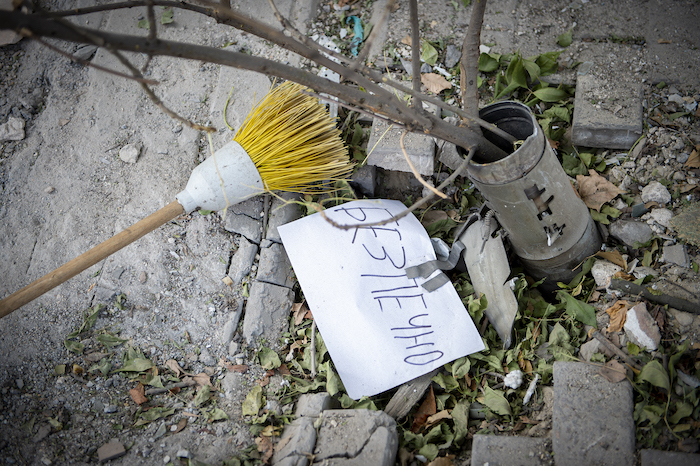
The power of community
Russian forces seized Kherson on 1 March 2022, during the first week of the full-scale invasion in Ukraine. During nine months of Russian occupation, the city endured violence, terror, and looting. Russians arrested and tortured civilians, but the resistance never waned.
On 30 September 2022, Russia annexed Kherson in a sham referendum, but on 11 November 2022, Kherson was liberated. In June 2023, the city faced an environmental disaster when the Russian military destroyed a dam, causing flooding and damage exceeding $2 billion. Community groups and volunteers rescued people and animals during the flood and later cleaned the mold and rubbish from the flooded houses.
From the first day of liberation, the Russian forces shelled the city and villages on the “right”—western—bank of the Dnipro River from the other side. In September 2023, the attacks on Kherson intensified.
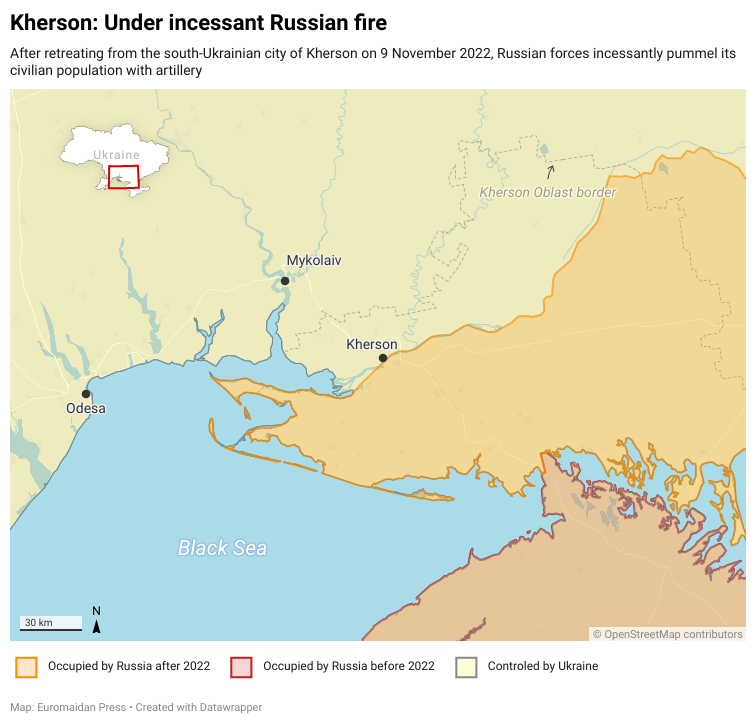
The secret to Kherson’s invincibility is community. During nine months of Russian occupation, the ecological catastrophe, and almost a year of non-stop shelling, Kherson community life offered not just material help but much-needed psychological support. Neighborhoods create groups and work together on building humanitarian aid hubs and bomb shelters, aid the military, and procure and deliver food and medicine to those in need, risking their own lives.
As destruction continues daily and attacks increase in number, churches, and synagogues provide material help to the vulnerable and spiritual support to believers. Father Afanasiy, the priest of the Ukrainian Orthodox Church of the Holy Spirit, hit by a Russian MLRS rocket on 2 October 2023 at 4.30 in the morning, cleaned the rubble along with his staff. He opened the doors at 8.30 for a morning prayer—in the basement of the cathedral. Another rocket, undetonated, still sat in the basement of an adjacent building.
https://twitter.com/ZarinaZabrisky/status/1708853806065172484
The chief rabbi of Kherson and Kherson Oblast, Yossef Itzhak Wolff, having survived a near-deadly encounter with the Russian military during the occupation, continues to risk his life to evacuate residents and deliver aid since the start of the full-scale invasion. A women's club offers free psychological help, hygiene products, and even aerobic classes—in a basement.
Where is the world community?
Even though the spirit is high, the resources are scarce.
“Kherson is still standing,” said Andriy, a volunteer who delivers food to hard-to-get villages. “Yet, no one knows what’s happening here. The world paid attention when we were liberated and when we were flooded. Now, everyone forgot about Kherson.”
Many other Kherson residents expressed the same sentiment. Indeed, the mass media does seem to have a blind spot for the daily killing of civilians by the Russian military and for the humanitarian crisis in the region. While the Ukrainian counteroffensive makes headlines, the strategically critical city of Kherson is being overlooked.
One of the reasons is pure logistics: the lack of journalists on site. Getting a permit to report close to the frontline takes a long time due to operational security. Most media do not have the funds and time to wait and move to the other spots in Ukraine and elsewhere. Hotels are being attacked regularly. Finding a safe accommodation is problematic. Most buildings are at least half-deserted, and looting is not unheard of. The Russian military monitors and targets the vehicles indicated with press signs and individuals in bulletproof vests and helmets, with or without press marks. Phone conversations are often intercepted, and locals avoid sending exact addresses, so meeting for an interview is often a challenge.
Yet, the lack of reporting on the escalating Russian assaults leaves the world unaware of the destruction of Kherson. International attention is urgently needed to address the intensifying attacks and their devastating impact.
Related:
- Australian company releases Kherson Liberation Gin to raise money for de-mining in Ukraine
- The unsung heroes of the first battle for Kherson
- Life in liberated Kherson: euphoria, blackout and Russian bombs
- “We couldn’t believe it!” Kherson residents on being freed from Russian occupation
- Russian strike destroys hospital in Kherson Oblast
- Russia shells Kherson, killing one, injuring six, including two children
- Russia’s destruction of Kakhovka dam: five blows to economy, environment of world and Ukraine

